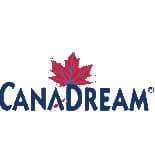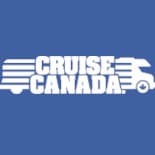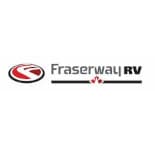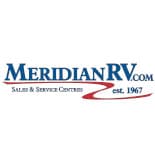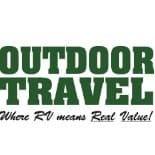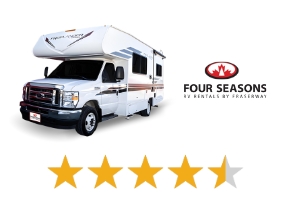
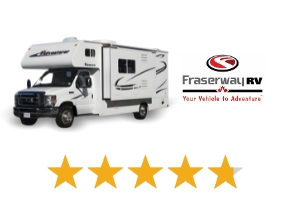
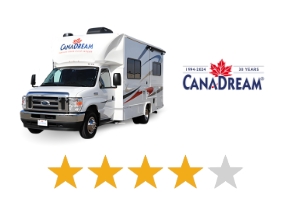
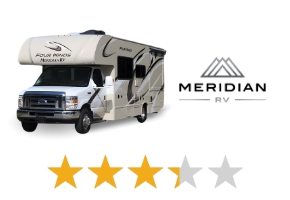
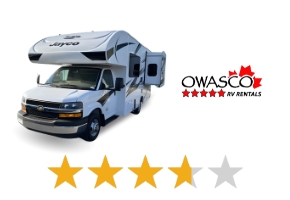
Compare campervans from multiple suppliers in Canada in one place with Camper Champ.
RV rental rates in Canada range from $50-$450/day for most vehicles. Prices however are dependent on vehicle type, seasonality and other factors. Many suppliers offer popular Class C RVs with brands such as Cruise Canada, Meridian, Fraserway and Canadream being especially popular.
Canadians are well-versed in the RV lifestyle, so you’ll find many facilities catering to life on the road. From modern RV parks to beautiful campsites surrounded by nature and plenty of scenic routes to get you from point A to B, the Canadian motorhome experience is one of the best in the world.
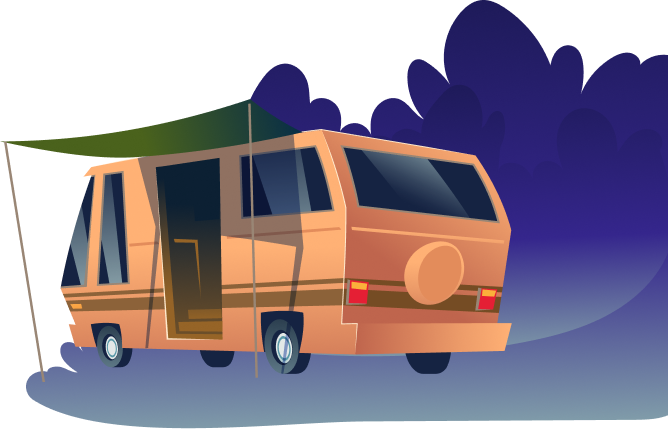
Discover Canada your way by choosing a class of RV that suits your travel needs.
Not all vehicles may be available. Use the search tool to check availability for your travel dates.
When it comes to hitting the open road in style, nothing beats the experience of journeying in an RV or Recreational Vehicle. These nomadic homes on wheels provide the unique fusion of travel and comfort, allowing you to explore the vast landscapes of Canada with the conveniences of home at your fingertips.
The world of RVs offers a rich array of options, each with its advantages and considerations. Your choice will depend on your budget, travel needs, the size of your travelling party, and your comfort preferences. Whether you're a solo adventurer looking for a compact camper or a family seeking a home away from home, there's an RV model class for you.
However, with the variety of RV classes available on the market, it can be overwhelming to identify the perfect fit for your travel needs. We’ve delved into the primary RV model classes and unravelled their unique features.
Think of these as the luxury yachts of the highway. Class A motorhomes are the largest and most luxurious RVs available, often ranging from 26 to 45 feet in length. They're built on specially designed motor vehicle chassis and resemble a bus in shape, with a flat or vertical front end and large windows. Amenities may include king-sized beds, full bathrooms, kitchen, living area, washer/dryer, and entertainment systems.
While Class A motorhomes offer unrivalled luxury and space, they also have a higher price tag and less fuel efficiency. Maneuvering them can be challenging for beginners, and you may encounter restrictions on where you can park due to their size.
Despite the 'B' in the name, these are the smallest motorhomes, also known as campervans. Class B RVs are built using standard van bodies, which manufacturers outfit with sleeping, kitchen, and bathroom facilities.
Class B motorhomes typically range between 18 to 24 feet long. They are easier to drive, park, and maintain, offering fuel efficiency. Although they lack the spaciousness of Class A and Class C motorhomes, modern designs and innovative features ensure they utilise their limited space exceptionally well.
A Class C motorhome is somewhat of a middle-ground option between the Class A and Class B motorhomes. They are built on a truck or van cutaway chassis with an attached cab section, distinguished by an over-cab sleeping area. The length can range from 20 to 33 feet.
These motorhomes offer more sleeping capacity than Class B motorhomes, and they often include similar amenities to those found in Class A models but on a smaller scale. They're easier to drive than a Class A and offer a good balance of luxury and maneuverability.
Travel trailers are towable RVs that come in a wide range of sizes, from tiny teardrop trailers to expansive two-story giants. These non-motorized RVs are designed to be towed by a car, SUV, minivan, or pickup truck via a bumper or frame hitch.
Travel trailers offer great versatility and can accommodate various travel needs and budgets. They're detachable, so you can use your vehicle for day trips or errands once you've set up camp. However, towing can be challenging, especially for first-time RVers.
The fifth-wheel trailers are the most spacious of the towable RVs, designed to be towed by a pickup truck using a special hitch in the truck bed. They offer many of the same amenities as Class A motorhomes, including slide-outs to increase living space.
The hitch's design allows for easier maneuverability while towing, making it more stable and safer on the road. On the flip side, you'll need a compatible truck and the necessary skills to handle the size and weight.
These compact units are designed to be loaded onto the bed of a pickup truck. Truck campers offer sufficient sleeping space, a small kitchenette, and usually a compact bathroom facility. The primary advantage of a truck camper is its mobility and compactness. They are perfect for adventurers who frequently travel off-the-beaten-path or in areas with tight spaces. With a truck camper, you can essentially camp anywhere your truck can go.
However, the living space in a truck camper is minimal, making them ideal for solo travellers or couples. While they don't provide the comfort of larger RVs, their flexibility and affordability make them a great choice for rugged, adventurous travel.
Pop-up campers, also known as fold-out campers or tent trailers, are a lightweight, affordable option perfect for novice RVers and camping enthusiasts. When in transit, these trailers are compact and streamlined. Once you reach your destination, they expand (either by cranking a handle manually or through an automatic system) to reveal sleeping areas and modest living spaces.
Some pop-up campers have basic amenities like a small kitchenette and a portable toilet. The main advantage of a pop-up camper is its ease of towing and storage. On the downside, they lack the insulation and amenities of larger RVs and may not be the best choice for colder climates or luxury-seeking travellers.
As the name suggests, hybrid trailers are a mix—in this case, a combination of a hard-sided travel trailer and a pop-up camper. They feature expandable tent sections, typically at the front, rear, or side of the trailer, providing extra sleeping quarters.
Hybrid trailers offer more living space than traditional pop-ups while maintaining a lightweight design that's easy to tow. They typically include more amenities than a pop-up camper but fewer than a traditional travel trailer. While the canvas sleeping areas allow for a more immersive nature experience, they offer less protection from the elements.
Park model RVs, also known as recreational park trailers, are unique in the world of RVs. They are designed to look like a home and are meant for seasonal use, typically in RV parks or campgrounds. While they're transportable, they're not meant for regular travel.
At around 400 square feet, park models offer plenty of living space, including full-size appliances and a comfortable bedroom, making them perfect for individuals or families who want to maintain the comforts of home while on the road.
Your campervan holiday through Canada will vary immensely depending on where (and when) you visit. Still, one thing is certain—you’ll never tire of the scenery. The Canadian motorhome experience gives you the freedom to explore at your own pace and the convenience of having all your essentials close at hand.
Affordable: Combining your transportation and accommodation expenses will slash your budget significantly, leaving you extra cash for other fun activities.
Convenient: Canada is MASSIVE, and if you want to see more than one area, you’ll need to spend some time on the road. Travelling via campervan is the key to road-tripping in Canada, and you’ll find plenty of campgrounds to roll into as you explore.
Flexibility: If you have commitment issues with detailed itineraries, we understand. One of the biggest perks of renting a motorhome is choosing your own adventure and leaving room in your plans for pleasant surprises.
Spend more time outdoors: Chances are high that you like spending time outdoors if you’re hiring a motorhome in Canada. Why overspend on a tiny hotel room when you can fall asleep listening to the sound of nature at a secluded campsite?
On-board facilities: Keep all your creature comforts close at hand as you traverse the vast expanses of “the Great White North”.
Remember these helpful tips when driving around Canada in an RV rental:
There aren’t a lot of toll roads in Canada, but there are a few in the Eastern provinces (Ontario, Quebec, Nova Scotia, and Prince Edward Island).
Most tolls have transponders, but you can also pay by cash or card. Be sure to check with your rental company about their policy on toll roads if you plan on driving through any of these provinces.
Due to its sheer size, exploring every nook and cranny of Canada is all but impossible in a single lifetime. Instead, pick just one region, figure out your bucket list of must-dos within that area, and plan a route around them. It’s important to note that much of Canada is undeveloped, especially within the northern reaches. The south is much more accessible in terms of paved roads and campervan-friendly facilities.
Ranging from the rugged shores of the Pacific Ocean through the Canadian Rockies and beyond, Western Canada is what dreams are made of.
British Columbia and Alberta are the most popular provinces for campervanning, thanks to the host of world-famous national parks, charming beach towns, and absolutely breathtaking mountain vistas. You could spend your holiday bouncing between Jasper, Banff, and Yoho national parks, using Vancouver or Calgary to pick up and/or drop off your motorhome.
You could also explore the verdant hills and valleys of Manitoba or coast the Trans-Canada Highway through the rolling plains of Saskatchewan.
Canada’s Eastern provinces are just as impressive as the Western ones, so buckle up for a memorable ride.
This large region packs a big punch, from New Brunswick’s Fundy Coastal Drive and the scenic seaside towns of Prince Edward Island to the quaint mountain villages in southern Quebec and endless outdoor activities in southern Ontario.
Start your motorhome holiday in Montreal, Quebec, or Toronto and explore underrated national parks, or head to Halifax and spend your trip ambling around Nova Scotia, New Brunswick, and Prince Edward Island.
Canada’s northern region may be large, but it’s pretty small in terms of offerings. This region claims nearly half of the country’s landmass, but about 90% is uninhabitable due to rugged terrain and freezing temperatures. So, not exactly ideal for exploring via motorhome!
The absolute wilderness does call for more adventurous types, and exploring some of this untouched region on a campervan holiday in Canada is possible. Yukon and the Northwest Territories have more facilities available to RVers, along with plenty of gorgeous scenery that you’ll have mostly to yourself. Those who take this road less travelled (read: rarely travelled) can look forward to the pure, unspoiled wilderness, endless breathtaking views right from the driver’s seat, and lots of wildlife. Highlights in northern Canada that are pretty accessible to campervans include the areas around Yellowknife, Whitehorse, and Fort Smith.
Remember that exploring Canada’s northern region will take a lot of advanced planning. You’ll need to know exactly where you can get gas, which roads are accessible with your motorhome, and which campsites you can pull into, as options are sparse this far north.
Several companies will allow you to fit a bike rack to the campervan. Please note that bike racks may not be available for all makes and models and usually must be reserved in advance.
Canada has thousands of campgrounds, which usually cost around $40–90 (Canadian dollars) per night.
A few popular choices in Vancouver are the Capilano River RV Park, the Burnaby Cariboo RV Park and Campgrounds, and the Dogwood Campgrounds & RV Park.
No, wild camping is not permitted in Canada. You may only sleep in a campervan at campgrounds. Spending the night at rest stops or car parks is strictly prohibited.
Canada has thousands of campgrounds, and these usually cost around $40–90 (Canadian dollars) per night.
An exception may be the local Walmart; campers in Canada may be able to spend a night in the store lot with permission from the store manager.
Generally, yes – many Canadian campervan companies will allow you to travel to the USA in your rental vehicle. Check the policy of your preferred supplier for details and terms.
You must comply with visa and customs requirements at all times.
The majority of rental companies in Canada do not offer unlimited kilometres as a standard rental inclusion.
In most cases, kilometres are capped at a daily rate, and additional fees will be incurred if you exceed this cap. Additional kilometres can often be purchased in packages. Unused kilometres are not refunded when the vehicle is returned.
All drivers must have a current and full driver’s licence to hire a vehicle. Foreign licences are acceptable if they are in English or French, or accompanied by an accredited translation. If your licence is in a language other than English or French, an International Driving Permit (IDP) is required.
Even if your licence is in English or French, if you plan to visit Canada for a longer period of time (3 months or more), you may be required to obtain an IDP as well. The rules vary between provinces, so make sure to check in advance and take note of local regulations.
Note: policies vary from supplier to supplier. Always check the T&Cs for your rental.
